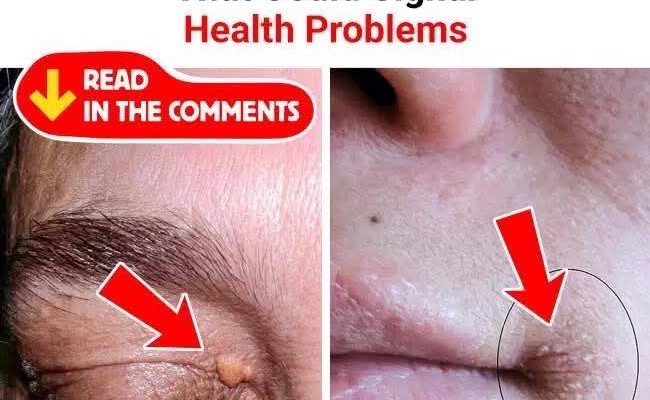Have you ever paused to inspect your face and stumbled upon something surprising?
While we often focus on how our face expresses emotions, it is also a powerful indicator of our overall health and vitality. From subtle changes in skin texture to unexplained bumps or discoloration, your facial features could be signaling potential health issues.
It’s easy to overlook these signs, but paying attention to them can help you spot potential issues early on, enabling you to address them before they worsen into more significant problems. Let’s explore four facial changes that can provide insights beyond just your current mood.

Your appearance can provide valuable clues about your health. From xanthelasma to melasma, here are four subtle facial signs that could indicate underlying health problems.
Our faces not only express our emotions, but they also offer valuable clues about our overall health and well-being. Even minor changes in your skin, eyes, or facial features can be early indications of underlying medical conditions. Identifying these signs in a timely manner can lead to early diagnosis and appropriate treatment. These are four facial changes to be mindful of that may suggest underlying health concerns.
1: Xanthelasma is a condition where yellowish deposits develop under the skin, typically around the eyes.
Xanthelasma appears as yellowish patches or bumps that form around the inner corners of the eyes. This condition arises from the buildup of cholesterol beneath the skin and, although not harmful on its own, may be associated with high cholesterol, liver problems, or thyroid issues.
Around half of people with xanthelasma have high cholesterol levels, which could be linked to genetic factors or liver issues. Even if your cholesterol levels seem to be within the normal range, the presence of xanthelasma might indicate a potential risk of developing heart disease in the future.
To reduce the chances of developing heart disease, focus on maintaining a healthy diet, engaging in regular exercise, and effectively managing cholesterol levels. If the situation persists, it is advisable to seek medical advice from a healthcare professional to explore alternative treatment options.
Angular cheilitis is a condition that leads to inflammation and cracking of the corners of the mouth.
Angular cheilitis manifests as redness, cracks, or soreness at the corners of the mouth. It often occurs due to infections, nutritional deficiencies (such as not getting enough vitamins b, iron, or zinc), or not taking proper care of the mouth.
This condition is more common in older people and can be worsened by dentures that don’t fit well, dry mouth, or excessive lip licking. Incorporating a diverse range of vital nutrients into your diet can aid in preventing it. If the symptoms continue, it is recommended to consult a healthcare professional to assess if there are any deficiencies or infections contributing to the symptoms.
Melasma is a skin condition that results in the appearance of dark patches on the face, particularly on the cheeks, nose, and forehead. It is more prevalent in women than men, and it can be caused by hormonal fluctuations, excessive sun exposure, or the use of specific medications. Unfortunately, there is currently no known cure for melasma, but it can be managed through the use of topical creams, light therapy, or chemical peels.

Melasma is identified by the presence of brown or grayish-brown patches on the face, commonly found on the cheeks, forehead, nose, and above the upper lip. It is more prevalent in women, especially during pregnancy or when using birth control, as hormonal changes are recognized as a common trigger.
Melasma is not dangerous, but it can impact one’s self-confidence. In certain instances, it may gradually disappear after the completion of pregnancy or the cessation of hormonal therapies. Anxiety may also contribute to its advancement. Dermatologists may recommend treatments such as topical creams, chemical peels, or laser therapy to assist in managing the condition.

4: Milia is a skin condition that causes small white bumps on the face.
Milia are tiny, white or yellowish bumps that frequently develop around the eyes, cheeks, or forehead. These benign cysts develop when keratin, a skin protein, gets trapped beneath the skin’s surface.
Unlike acne, milia are not caused by blocked pores or bacteria. They can develop as a result of skin injuries, prolonged exposure to the sun, or the prolonged use of steroid creams. In most cases, milia naturally disappear without any intervention, but if they persist, a dermatologist may need to extract them.
Your face not only displays your emotions but also provides insights into your overall well-being. Being mindful of any unusual bumps, patches, or skin conditions can aid in the early detection of potential health problems. If you observe persistent or worrisome symptoms, it is advisable to seek medical advice from a healthcare professional to obtain an accurate diagnosis and receive suitable treatment.
In summary, the slight alterations in your facial features can provide valuable insights into your overall well-being. Conditions such as xanthelasma, angular cheilitis, melasma, and milia may appear insignificant, but they can indicate more serious health problems that necessitate medical intervention. By carefully observing these facial indicators, you can take prompt action to address any potential issues, resulting in improved outcomes and timely treatment.
It is crucial to seek medical advice if you observe persistent or worrisome alterations in your health, as this will facilitate an accurate diagnosis and the development of an appropriate treatment plan. Your facial expressions might be conveying crucial information about your well-being.



